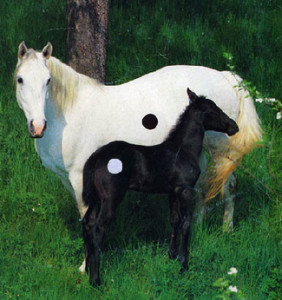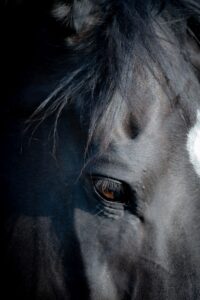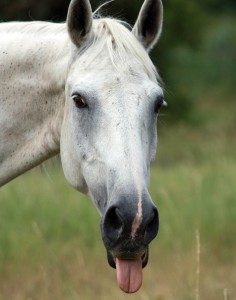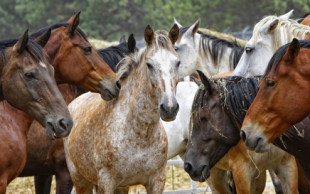“The motion of Yin & Yang generates all things in nature.”
–Meh juizhang
-

photo credit: Eva Kovacovsky, Horses, 2005 - Horse Wisdom
- 7 Questions to Find your Yin or Yang Nature?
The basic Taoist concept of Yin-Yang is based upon the idea that two natural, complementary and contradictory forces exist in our universe: Yin – the feminine, and Yang – the masculine. All forces can be classified as either Yin or Yang. These opposite forces mutually complement one another and are in dynamic equilibrium. As one aspect declines, the other increases to an equal degree — striving for that harmonious equilibrium of BALANCE that we all seek.
Similar to the energies of the universe, each individual has their own unique personality traits and both Yin and Yang energies. In addition to understanding and embracing our own natural Yin and Yang energy, we must work towards an equal respect for our opposing energies, as both are necessary for a fully functioning existence.
“The circle that represents the whole is divided into Yin (black) and Yang (white) halves–two polar complements in harmonious balance. The two smaller circles in the centers (the eyes), shaded in the opposite color, illustrate that within Yin there is Yang, and vice versa. Yin and Yang contain within themselves, at their very centers, the seeds of change. The curve dividing them indicates that this change is dynamic and continuous. Each half invades the other half and establishes itself in the center of its opposite.” – Simmone Kuo
The fundamental characteristics of Yin-Yang are:
- Opposition
They struggle with and control each other. One example of this in nature is high and low pressure systems in meteorology. - Interdependence
They define each other. Neither can exist without the other. There would be no male without female. Without day, there would be no night. - Mutual Consumption
Yang (activity) consumes Yin (substance). For example, we burn fat and lose sweat when we exercise and it takes energy (Yang) to create and store fat (Yin). - Inter-transformation
They become each other. The dot in each half of the symbol represents the “seed” of the other. Yang contains the seed of Yin and vice versa. Night gradually gives way to day, which gradually gives way to night. If we push too hard in an active (Yang) way, a restive (Yin) state will follow (exhaustion, death)
 Yin represents the dark and its characteristics include those that are “feminine”, passive, receptive, and sensitive such as: Nurturing, Intuitive, Relaxed, Imaginative, Quiet, Introverted, Night, Earth, Moon, Water, Softness, Moisture, Sadness, Contemplative, Downward seeking, Slow, Consuming, Cold, Winter, Rest, Structure, Contracting, Inward, Front of body, Mutable, Bending, Allowing, Negative, Empty, Odd Numbers, Shakti, the container.
Yin represents the dark and its characteristics include those that are “feminine”, passive, receptive, and sensitive such as: Nurturing, Intuitive, Relaxed, Imaginative, Quiet, Introverted, Night, Earth, Moon, Water, Softness, Moisture, Sadness, Contemplative, Downward seeking, Slow, Consuming, Cold, Winter, Rest, Structure, Contracting, Inward, Front of body, Mutable, Bending, Allowing, Negative, Empty, Odd Numbers, Shakti, the container.
 Yang represents the light and its characteristics include those that are “masculine”, active, producing, and rational such as: Enthusiastic, Direct, Mental, Excited, Outgoing, Logical, Day, Heaven/Air, Sun, Fire, Hardness, Dryness, Joy, Reactive, Upward seeking, Fast, Restless, Productive, Hot, Summer, Activity, Function, Expansive, Outward, Back of Body, Rigid, Unwavering, Dominant, Controlling, Positive, Full, Even Numbers, Shiva, the contents.
Yang represents the light and its characteristics include those that are “masculine”, active, producing, and rational such as: Enthusiastic, Direct, Mental, Excited, Outgoing, Logical, Day, Heaven/Air, Sun, Fire, Hardness, Dryness, Joy, Reactive, Upward seeking, Fast, Restless, Productive, Hot, Summer, Activity, Function, Expansive, Outward, Back of Body, Rigid, Unwavering, Dominant, Controlling, Positive, Full, Even Numbers, Shiva, the contents.
In the Tao Te Ching, Lao Tzu says: “Know the Yang but keep to the Yin.” When necessary, horses express the Yang, however, they live primarily in the Yin. From them, we can learn to live in the present, connect with and follow our intuition, nurture relationships, be receptive and cooperative, and bring swift, clear communication and leadership when needed. They also demand that we bring the strength of Yang and the sensitivity of Yin. In order to effectively relate with them, we must learn to be assertive and nurturing, dominant and flexible, intuitive and direct. Through connection with our own Mare Wisdom and Stallion Strength we can create positive change in ourselves and the world around us.
How can we learn to understand the Yin & Yang elements within ourselves and use this knowledge to bring about a more balanced and harmonious experience?
Here are 7 questions to ask yourself to identify your Yin or Yang nature.
1- How important is it for you to be the one in control? Maintaining “control” is a Yang quality – its opposite would be passivity or even “going with the flow” – allowing more freedom for the outcome of things to be different than expected or for things to change (Yin).
Which are you? Would you rather be the one in control or do you prefer to let someone else take the reigns? Perhaps you are a blend of the two. Recognize that the “masculine” idea of having the control, being the leader, the director or the dictator is definitely not a gender specific quality.
An imbalance of either too much Yang or too much Yin has its drawbacks. Being able to recognize the our own tendencies and develop the flexibility to move between the two is optimal. For instance, too much Yin without any Yang energy present results in a loss of boundaries and direction. Too much Yang without any Yin energy results in rigid, authoritarian behavior at the expense of self and other.
2 – How noticeable are you in a group? Are you the one in the spotlight or do you like to stay quietly behind the scenes. Whether you are a natural introvert or extrovert is a key clue into your Yin or Yang nature. How much and how often do you contribute verbally? Are you more comfortable in one-on-one discussions or perhaps you love to take the stage?
 The Yang quality is that of the extrovert – action, high vibrational energy, lots of sound, lots of talk, lots of movement – these are all the aspects that depict the Yang. Those who are drawn to a more intimate, low-key experience are being guided by their Yin nature – maybe you like to seek out a quiet moment alone or prefer to offer support anonymously, this is Yin.
The Yang quality is that of the extrovert – action, high vibrational energy, lots of sound, lots of talk, lots of movement – these are all the aspects that depict the Yang. Those who are drawn to a more intimate, low-key experience are being guided by their Yin nature – maybe you like to seek out a quiet moment alone or prefer to offer support anonymously, this is Yin.
Next time you find yourself in a large group or public situation, notice yourself – are you drawn to Yin on Yang behaviors? Maybe it changes depending on your mood or the situation, this is a perfect example of how Yin & Yang are always in constant flux. I encourage you to play around a bit and see how it feels — if you are comfortable acting one way and not the other you’ll know it, but you can always learn something from the other side of the coin.
3 – What is your physical energy level usually like? Do you gravitate towards vigorous exercise or still meditation? The types of movement (or stillness) your body is drawn to is a reflection of your Yin or Yang nature.

Are you typically more hyper or chill? Is your heart’s desire to go rock climbing on your birthday or to go to the spa? Would you rather splash in the pool or float? One is Yang the other is Yin – which do you prefer? Knowing this about yourself will lead to great insight about why you may feel more comfortable in some situations than others.
4 – Which emotions do you quickly lean toward? Different emotions are easier for some than others. Sadness is certainly a Yin emotion. This explains why it is often easier for women to connect with sadness and feel more comfortable crying; however, it is certainly not a quality that only women hold – just as “femininity” and Yin nature are not gender specific.
If you ever suffer from inexplicable sadness, or depression, it is likely that you have an imbalance of too much YIN. Bringing more Yang energy into your life in any of its forms – physical exercise, laughter, sunshine, energetic puppies – can help to balance your Yin-Yang energy and ease depression.
Happiness and anger are both Yang emotions, they are outward, expressive, often loud emotions! Notice which emotions come easiest for you next time you go to the movies – if you cry easily during a Disney movie you’re probably more in touch with your Yin energy, if you find yourself cracking up with laughter uncontrollably at a comedy your Yang is strong!
5 – At what time of day do you feel happier? To some it’s very clear – “I’m a morning person” or “I’m a night owl”. The light, the day, the morning is the Yang – the dusk, the night, the dark is Yin.
You might feel happier, more comfortable, more vibrant and at home during a certain time of day. Notice this about yourself as you go throughout your day (or night). When did you feel your best? Was it dark or light out?
It may seem pretty obvious that if you feel better during the day then you must be Yang and if it’s night you must be Yin – but that may not necessarily be so. Sometimes, we are drawn to our opposite, especially if there is an imbalance. So, if your answer to most questions on this list is Yang but you are drawn to the night – you may be seeking more Yin.
6 – What is your most typical reaction to others? Yo ur friend has broken up with their significant other AGAIN for the “you’ve lost count by now!” number of times. How do you feel – compassionate or annoyed? The way we react to others is a major clue into our own nature and the energy that we give out to others. Compassion, patience, understanding and listening are all Yin qualities. Reacting quickly or impulsively, blaming, and being offended or confrontational are Yang behaviors.
ur friend has broken up with their significant other AGAIN for the “you’ve lost count by now!” number of times. How do you feel – compassionate or annoyed? The way we react to others is a major clue into our own nature and the energy that we give out to others. Compassion, patience, understanding and listening are all Yin qualities. Reacting quickly or impulsively, blaming, and being offended or confrontational are Yang behaviors.
Noticing the way you interact with others will show you what kind of energy, Yin or Yang that you are putting out. Notice whether others are drawn toward you are or move away from you.
7 – Where do you prefer to dwell? Elements of nature also have Yin or Yang assigned to them. The type of surroundings you prefer reflects which energy you are more drawn to.  Earth and water are Yin elements and so if you love to swim or be in earthy nature, you are seeking Yin. Air and fire are the Yang elements, so if you enjoy heights with lots of wind, hot places like the desert, or big cities with lots of lights and activity you are drawn to Yang.
Earth and water are Yin elements and so if you love to swim or be in earthy nature, you are seeking Yin. Air and fire are the Yang elements, so if you enjoy heights with lots of wind, hot places like the desert, or big cities with lots of lights and activity you are drawn to Yang.
Learning to be “in your element” is a powerful tool. Bringing Yin or Yang elements into commonplace areas such as your home or office can help to balance your energy and make you feel more comfortable and at ease. For instance, if you can’t get out to nature, you can bring nature to you in the form of water features, a zen rock garden or metal paperweights (Yin); bright lighting, fire features, an actively blowing fan or plants can bring you Yang.

